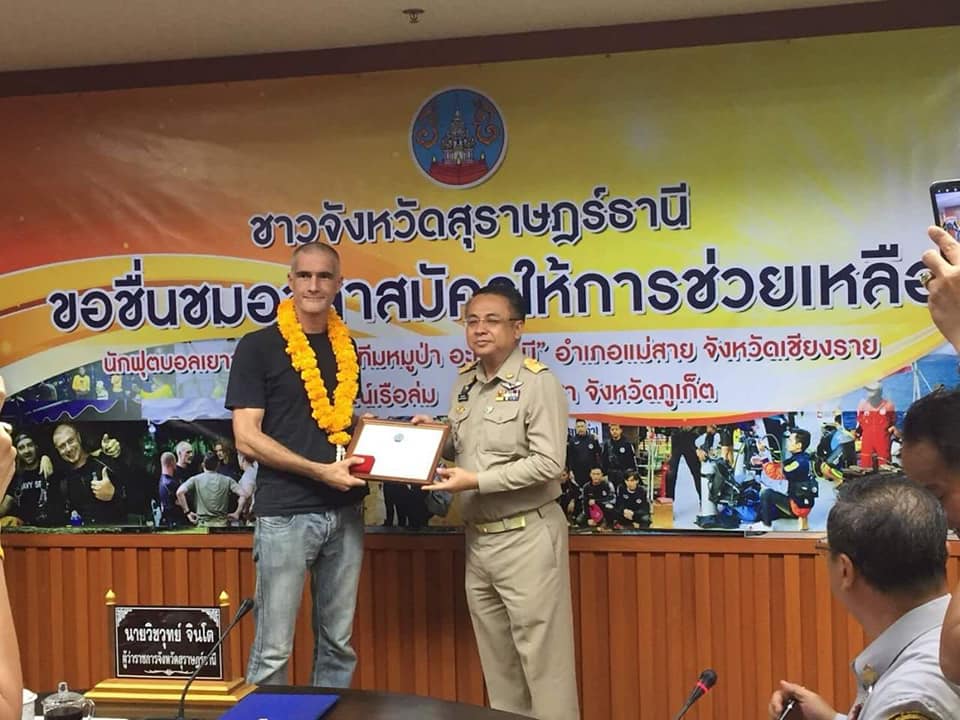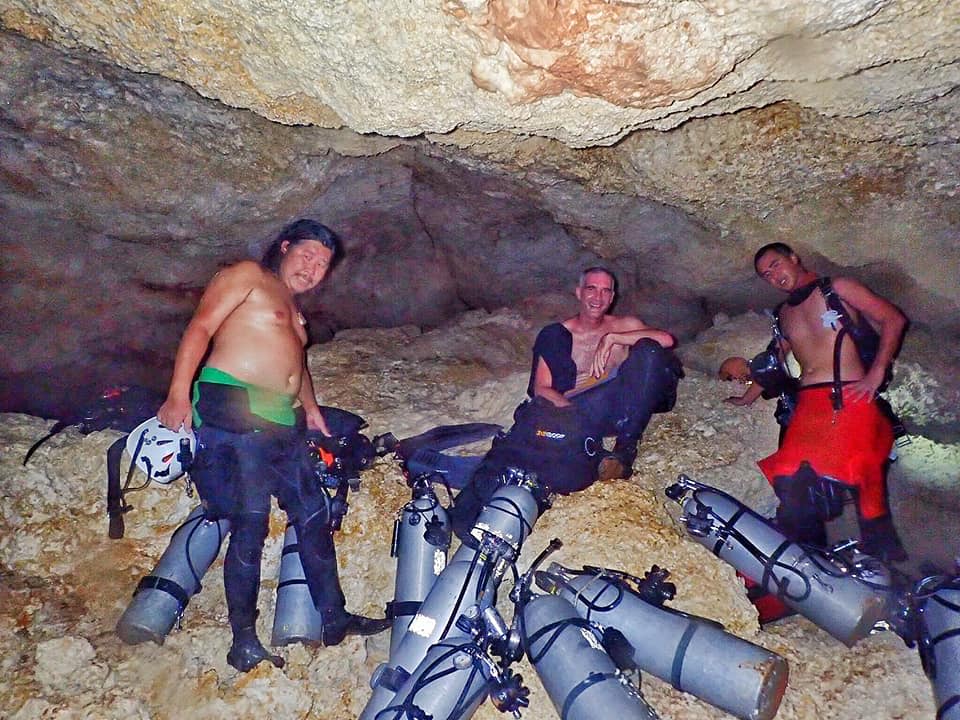1 Dedicated diver who nearly died:
Not all heroes wear capes, some wear scuba gear.
More than six months ago, a dozen Thai soccer team-mates and their assistant coach found themselves trapped inside the Tham Luang cave. Entering it had become a post-practice ritual for the boys, who were very familiar with its Delphic interior.
When heavy rainfall unexpectedly flooded the entrance of the cave, however, the boys swiftly realised the danger they were in. Monsoon season had come earlier than anticipated, and the team crept further and further into the cave.
The government initially recruited their native Royal Thai Navy SEALs to rescue the team, but as the gravity of the situation became clearer, and with the rain continuously pelting down, they soon had to call on the world for help – and help came quickly. Professional divers from Australia, Belgium, the UK, and the US all made their way to the Chiang Rai province within the following days, along with two Danes: Claus Rasmussen and Ivan Karadzic.
Dane on the inside
Upon learning of the circumstances, Karadzic immediately closed his diving centre in Thailand and cancelled all courses for the next three weeks. He and his fellow instructors mobilised and quickly offered their services.
Danish-born Ivan Karadzic is a professional scuba diver and has lived in Thailand for the past 12 years. The owner of a technical diving center on the island of Koh Tao, Karadzic was one of the first volunteers when the news broke in June 2018.
And he was part of the courageous rescue effort that saw all 13 ‘Wild Boars’ saved from the flooded Tham Luang cave.
It took nine days before contact with the boys was established. Until then, the only indication of their subterraneous presence were the bicycles parked in front of the cave and a pair of flip-flop sandals in the muddy water by the entrance.
The team had taken refuge in the 9th chamber, which runs approximately 4.5 km into the Tham Luang cave. With only half a packet of toast bread and no water, it all seemed a hopeless predicament. A decline in clean air in the chamber confirmed time was working against them.
Fatal mission
On the outside, matters were looking equally difficult. The divers – whether military men or volunteers – all had intricate knowledge of cave diving. However, with no antecedent to draw inspiration from, and the dark and desolate conditions inside Tham Luang, the operation was planned and executed through trial and error.
The thick, ubiquitous mud deprived Karadzic and the other divers of their vision, compelling them to study maps of the cave intensively and then navigate by instinct once inside.
Saman Kunan, an experienced diver and former Thai Navy SEAL, died after delivering three tanks of oxygen to the children. His death was a tragic awakening; the other divers were reminded of the risks involved in such a mission.
Karadzic had never met Kunan before, but was nevertheless still affected by his demise. An uncommunicated pact was made between all the divers then and there: not a single other life was to be lost on this mission.
Engineers, soldiers and doctors also rallied together, and every conceivable way to retrieve the children was considered in unison. To anesthetise and transport the children out of the cave four at a time was ultimately declared the safest, most humane way to rescue them.
Close to death
The rescue mission had near-fatal consequences for Karadzic. After extensive labour on July 8, which saw the first four boys rescued, the spirited Dane went to bed at 2 am knowing the work was far from done.
Waking up the next day, Karadzic managed to throttle the urge to sleep on despite feeling horrible. His entire body ached; he was sweating profusely and suffering from an intense dizziness. Nevertheless, he managed to hail a cab and make his way to Tham Luang, with his condition only worsening en route.
Karadzic was admitted to the makeshift hospital by the cave, where his heart rate was recorded at 188 beats per minute. He was completely dehydrated and had little to no glucose left in his blood. Bedridden and dependent on intravenous fluids, Karadzic was not allowed back into the cave by the doctor, yet he remained in the area until all the children and their coach came out alive on July 10.
Mission completed
All 12 team-mates and their coach were saved from the flooded cave in a distinctive, painstaking joint rescue effort that left the world in complete astonishment.
As Thailand celebrated the successful conclusion to the mission, most of the hired divers returned to their respective countries.
Karadzic, however, did not travel far. He was born and raised north of Copenhagen, but relocated to the idyllic Koh Tao island more than a decade ago and now proudly calls Thailand his home.
Returning hero
Instantly hailed as a hero, returning to Koh Tao was an unusual experience for Karadzic. Upon his arrival at Suvarnabhumi, Karadzic was guided into a luxurious suite at the airport.
Inside the massively impressive room – which was covered in golden décor with huge, royal paintings on its walls – stood a personal servant of King Rama X. The assistant wanted to thank Karadzic on behalf of the kng and the people of Thailand, and he presented him with a gift.
Innumerable photos and a free airplane ticket later, Karadzic landed in Chumphon, where he was taken out for drinks and dinner to celebrate the success of the mission, and naturally Karadzic was also offered a complimentary stay at an ample hotel in the city. With a slight hangover the following morning, Karadzic was finally on the ferry back to Koh Tao, longing for a few hours of undisturbed sleep.
Instead, he was welcomed home by virtually all of the island’s inhabitants. A salvo of applause, singing and celebration awaited Karadzic as his ferry packed with unsuspecting tourists came ashore. Friends, monks and even the mayor of Koh Tao were present, all beaming with pride as their foreign neighbour returned.
Pick up our next issue of Diplomacy on February 21 to read our exclusive interview with Karadzic in which he reflects on his life and recalls his involvement in 2018’s most daring mission.
Best of the rest, by Stephen Gadd.
2 Nedim Yasar: They say that crime doesn’t pay and, to start with, Yasar was not one of Denmark’s most law-abiding citizens, with convictions for robbery, violence and drug dealing to his name. He was also a leader of a gang affiliated to Bandidos. However, his life took a turn for the better through a 2013 exit program, and he began the year as a well-liked radio host, student pedagogue and author. Unfortunately, the role model was shot dead after a book-signing for his autobiography in December.
3 Eske Willerslev: With academic honours and letters after his name a mile long, the professor belongs to the true elite of scientific research. His pioneering work on evolutionary genetics has included sequencing the first ancient human genome. This year he led a research team that examined bones and bone remnants found in Brazil in 1840 and found traces of DNA from the Pacific, which poses new questions about the origins of the first people in America.
4 Crown Prince Frederik: May 26 saw the 50th birthday of the popular royal, with over a week of events including a concert, portrait unveiling and the Royal Run. The latter took the form of four one-mile runs in Aalborg, Aarhus, Esbjerg and Odense, culminating in a 10 km run through Copenhagen and Frederiksberg. As if to emphasise Frederik’s ‘man of the people’ status, over 70,000 people took part across the five cities, making it the eighth largest running race by participation ever.
5 Margrethe Vestager: With her tough stance on multinational tech companies such as Google, Apple and Facebook, Denmark’s EU Competition Commissioner has garnered a lot of respect in Europe. It has also been pointed out that Vestager is the template for Birgitte Nyborg in the successful TV series ‘Borgen’. Now Vestager could reach even greater heights, as she is tipped for the top job when Jean-Claude Juncker steps down as president of the EU Commission.













